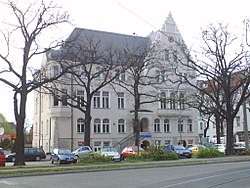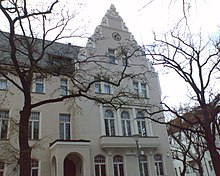Johannisthal town hall
| Johannisthal town hall | |
|---|---|
 Johannisthal town hall seen from Sterndamm |
|
| Data | |
| place | Berlin-Johannisthal |
| architect | Georg Roensch |
| Client | Johannisthal community |
| Architectural style | Neo-renaissance |
| Construction year | 1905-1906 |
| Coordinates | 52 ° 26 '36.9 " N , 13 ° 30' 8.4" E |
The historic Johannisthal Town Hall is located at Sterndamm 102 in the Berlin district of Treptow-Köpenick , Johannisthal .
It was built from 1905 to 1906 in neo-renaissance style for the then independent Brandenburg municipality of Johannisthal, which was incorporated into Greater Berlin in October 1920 .
history
The Johannisthaler Rathaus was built between 1905 and 1906 on the former Königsplatz based on a design by the Charlottenburg sculptor and architect Georg Roensch (other buildings include Juwel-Palais Berlin-Mitte , boathouse of the Berlin rowing club Berlin-Wannsee ). The costs at that time were 180,000 marks (adjusted for purchasing power in today's currency: around 1,109,000 euros)
It is a three-story plastered building with a high basement, with structures made of sandstone . For Sterndamm and Hoevelstraße are two high pediment. The west side was designed with an onion dome with pentagonal corner bay windows. During the restoration of the exterior, which was simplified after war damage in World War II , the roof tower, the tips of the ornamental gables and the balcony above the main entrance were removed. The property on which the monument stands was a gift from the heirs of Baron Carl Trützschler von Falkenstein.
On the ground floor of the town hall were the offices and on the first floor the meeting room with the pictures of King Friedrich II. And Kaiser Wilhelm II painted by Beckmann . Referring to the founding of Johannisthal in 1753, Friedrich the Great is depicted as a colonizer and Wilhelm II as an admiral been. These pictures have not been available since the years after 1945. The other two floors served as official apartments for the mayor and some community officials, the basement, as it is today, as a council cellar.
When it was incorporated into Greater Berlin in 1920, the function of the Johannisthal City Hall as the administrative seat of the municipality ended. A large part of the tasks was relocated to the Treptow town hall .
Until the end of the Second World War , the municipal office (branch office), the registry office , the map office for the administration and issuing of food cards , the municipal daycare center and a branch of the police station 234 ( Niederschöneweide ) were housed there.
At the beginning of the 1940s a new police station was built nearby, at Königsheideweg 248, but the criminal police remained in the town hall building even after 1945. In addition to the council cellar, there were also some police custody cells in the basement.
The use after 1945 as a town hall with various institutions, including the Ratskeller as a restaurant, continued until around the mid-1950s.
After that, until 1990, there was only the People's Police - in addition to departments of the Ministry for State Security (MfS) - to inspect the city district of Treptow in the town hall. After German reunification , the police moved to the building of the former district office of the MfS on Segelfliegerdamm .
The historic town hall could again be used for municipal purposes after renovations were carried out at a cost of 400,000 marks .
Since then, the Treptower Heimatmuseum has been located on the upper floor and in the garden house . Other rooms were and are used by the district office. In the 1990s, the district culture and education office was initially located in the house, after the merger of the Treptow and Köpenick districts in 2001 and the relocation of the district education office to Köpenick, the head of the district social and health department was also temporarily based there.
Since January 1993 the Ratskeller has been restored as a restaurant after numerous renovations, after it was used exclusively for police custody cells for a long time - until 1990 - and the separate access stairs to the street were even bricked up.
For the 250th anniversary of Johannisthal in 2003, the town hall clock, which had been defective for decades and had barely been recognizable , was restored through civic engagement by collecting donations and winning voluntary , manual work.
In the run-up to the 100th anniversary of the Johannisthal town hall, the building was gradually emptied and subjected to a comprehensive, listed interior and exterior reconstruction. The restoration of the roof tower, which was destroyed in 1945, as well as the balcony above the entrance was not done for cost reasons. The previously rarely used top floor has been given new office space. The reopening took place in October 2006.
The town hall Johannisthal since then by an elevator barrier-free accessible. It now serves as a socio-cultural center with a local museum, senior leisure center and event rooms. Previous plans to set up a library at the site have not been pursued since the Treptow Central Library opened in the Niederschöneweide district .
literature
- Anna Rohr: Function and importance of the former town hall of Johannisthal in the 20th century. Stapp Verlag, Berlin 2007, ISBN 978-3-87776-453-4 .




